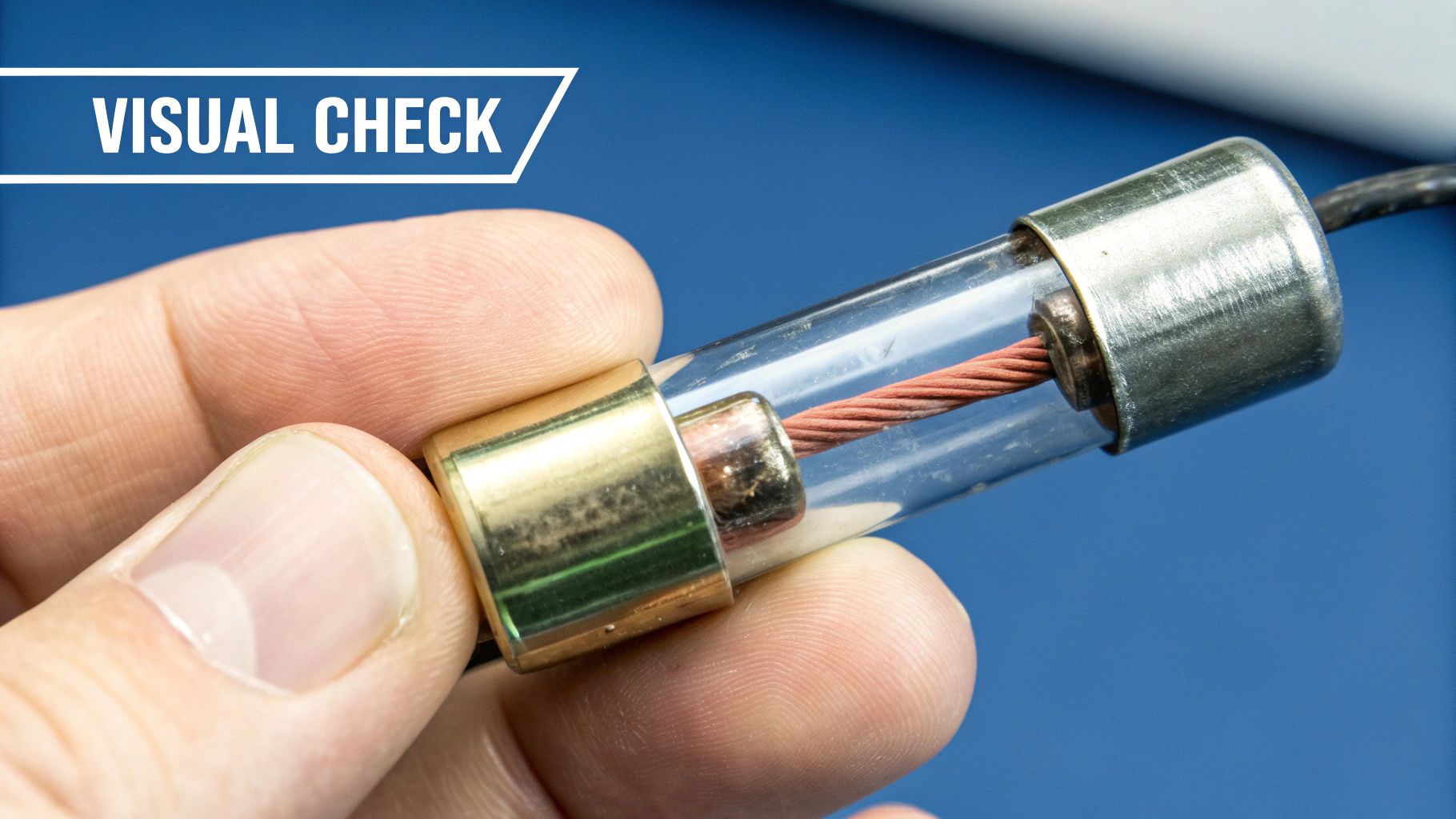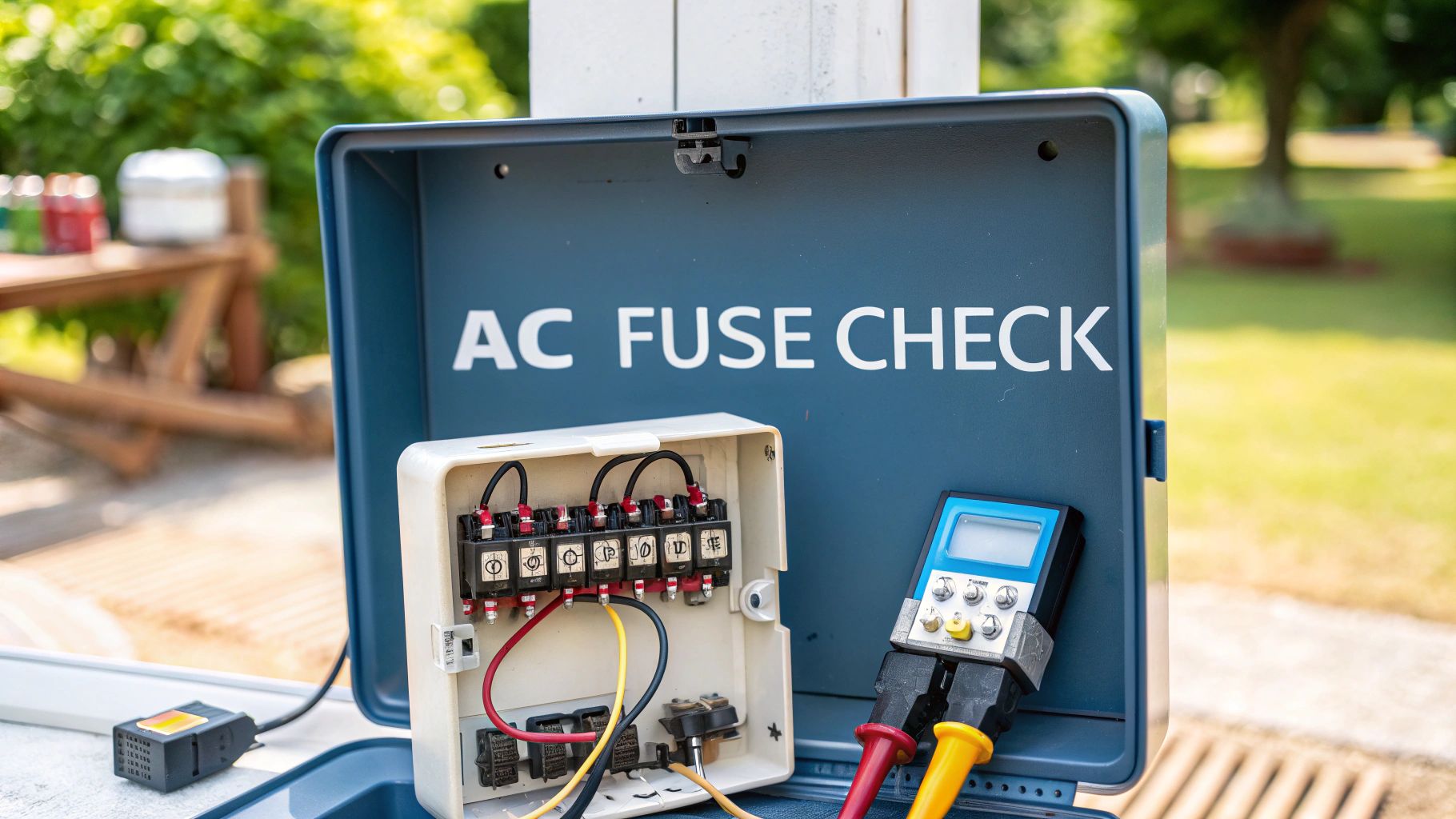It's one of those scorching hot days, and suddenly, silence. The reassuring hum of your air conditioner has vanished. Before you panic and assume the worst, take a deep breath. Often, the culprit is a small, inexpensive part: a blown fuse.
The most tell-tale sign? Your indoor thermostat looks perfectly fine, but the outdoor condenser unit is completely dead. No fan spinning, no compressor kicking on—nothing. This little fuse might just be the only thing standing between you and a comfortable, cool home.
Why Your AC Suddenly Stopped Working

When your AC goes silent on a sweltering day, it's easy to jump to conclusions about expensive repairs. But more often than not, the problem is much simpler. An AC fuse is a built-in safety measure, designed to fail first and protect your expensive equipment from an electrical surge or overload.
Think of it this way: when a fuse blows, it cuts power directly to the outdoor unit. This is why your thermostat can still be lit up and seem to be working, while the part of your system doing all the heavy lifting outside sits lifeless.
This specific symptom is a great clue. It helps you rule out other common issues. For example, if your whole house went dark, you'd head for the main electrical panel to check for a tripped breaker. But a blown AC fuse isolates the problem to the air conditioner itself. If you're seeing different symptoms, you might want to explore our guide on what to do when your air conditioner is not cooling.
A fuse is designed to be the weak link in the electrical chain. It's built to sacrifice itself during a power surge, preventing catastrophic damage to critical parts like the compressor or fan motor.
The widespread need for these safety components is huge. The global market for fuses and circuit breakers is on track to hit USD 22.45 billion by 2030, according to Grand View Research. This just goes to show how essential these small parts are for protecting our homes and appliances.
To help you figure out what's going on with your system, take a look at this quick diagnostic chart. It can help you compare your AC's behavior and see if a blown fuse is the likely culprit.
Quick Diagnostic Chart: AC Not Working
| Symptom | Likely a Blown Fuse If… | Probably Another Issue If… |
|---|---|---|
| AC Unit is Silent | The outdoor unit is completely off, but the indoor thermostat has power. | The entire house has no power (check main breaker). |
| Indoor Fan Runs | The indoor fan blows, but the air is not cold. | The fan doesn't run at all (could be a thermostat or motor issue). |
| System Shuts Down | The AC stops working shortly after starting up. | The AC won't turn on at all, even at the thermostat. |
| Breaker Hasn't Tripped | The AC circuit breaker in your main panel is still in the "ON" position. | The AC circuit breaker has tripped to the "OFF" or middle position. |
This chart is a great starting point. If your symptoms point toward a fuse, the next step is to locate it and test it.
Your Safety Checklist Before You Begin

Alright, before we even think about opening up your air conditioner, we have to cover the most important part: safety. This isn't the place to cut corners. You're dealing with high voltage, and a few simple precautions are all that stand between a successful DIY fix and a very bad day.
Let's start by getting your tools together. You won't need a professional-grade tool chest, just a few key items to do this job safely and correctly.
- Insulated Screwdriver: A good Philips or flathead with a thick, rubberized handle is non-negotiable. It's your first line of defense against accidental shock.
- Voltage Tester: This is a must-have. A non-contact voltage tester (sometimes called a "volt stick") lets you check for live wires without ever touching them.
- Multimeter: While the voltage tester tells you if power is on or off, the multimeter is the tool that will definitively tell you if the fuse is good or bad.
The Two-Step Power Shutdown
Killing the power to your AC unit isn't a one-and-done deal. You need to shut it off in two different places. If you miss one, the system can still be live, so make sure you do both every single time.
First, go to your home's main electrical panel. You're looking for the breaker that controls the air conditioner—it might be labeled "AC," "Air Conditioner," or "Condenser." Usually, it's a larger, double-pole breaker that looks like two switches fused together. Flip that switch to the "OFF" position.
Now, head outside to your condenser unit. Somewhere on the wall nearby, you'll see a small metal box. That's the outdoor disconnect box. Open it up. Inside, you'll find either a handle you can pull straight out or another circuit breaker switch. Pull the handle out or flip the switch to "OFF."
Critical Safety Check: Once you've shut down power at both spots, grab your non-contact voltage tester. Wave it near the wires inside the disconnect box to be absolutely certain the power is off. This final check for zero electrical current is your green light to safely proceed. Don't skip it.
Locating and Inspecting Your AC Fuses

Alright, with the power safely shut off, let's find those fuses. Thankfully, they're easy to get to. Head outside to your AC condenser unit and look for a metal disconnect box mounted on the wall right beside it. This box acts as the final power cut-off for the unit.
Open up that box, and you'll typically find one of two main designs inside. Knowing what to expect makes it simpler.
- A Pull-Out Handle: This is the most common setup I see. The fuses are clipped right onto the back of a black or gray handle. When you pull the handle straight out, it cuts the power and delivers the fuses right into your hand.
- An Enclosed Block: Less common, but still out there. Some boxes have a small, self-contained block that houses the fuses. You might have to flip open a little cover or door on the block itself to get to them.
No matter the style, what you're looking for are two cartridge-style fuses. They're shaped like small cylinders. You should be able to gently pry them out with your fingers, but a small, non-conductive tool can help if they're snug.
The Quick Visual Check
With the fuses out, it's time for the easiest diagnostic test there is: just look at them. This is often all you need to do to confirm you've found the culprit.
Hold each fuse up to the light and give it a close look. A bad fuse will usually give itself away.
- Look for a broken or melted filament inside the fuse.
- Check if the glass looks cloudy, hazy, or charred black.
- Inspect the metal caps on either end for any discoloration or burn marks.
This simple visual check has been the go-to first step for decades. In fact, it’s estimated that around 70% of fuse failures are spotted just by looking for these obvious signs of a break. You can find more deep-dive info on fuse diagnostics in this U.S. Nuclear Regulatory Commission report.
Pro Tip: If the fuse looks perfectly clear and the little wire inside seems intact, don't assume it's good just yet. A fuse can sometimes fail without leaving any visible clues. That's why the next step, testing it with a multimeter, is so critical for being 100% sure.
Using a Multimeter for a Definitive Answer
Looking at a fuse is a good first step, but your eyes can deceive you. Sometimes a fuse can blow without any of the classic signs, like scorch marks or a broken wire inside. This is where a multimeter comes in handy—it’s the only way to get a 100% certain answer.
This quick process shows the basic steps for safely testing a fuse.

As the infographic shows, the most important thing is to always kill the power before you touch anything. Safety first, always.
Setting Up Your Multimeter
To test the fuse, you'll be checking for what's called continuity. This setting tells your multimeter to send a very small electrical signal through the fuse to see if the circuit is complete or broken.
Grab your multimeter and turn the dial to the continuity setting. The symbol usually looks like a sound wave or a diode (a triangle with a line).
Before you test the fuse, touch the two metal probes of the multimeter together. You should hear a solid beep. That's how you know the meter is working right and you're ready to go. If replacing the fuse doesn't solve your problem, our air conditioning troubleshooting guide has more tips for what to check next.
Performing the Continuity Test
With your meter set up, take one of the fuses you pulled from the disconnect box. Place one of the multimeter’s metal probes on the metal cap on one end of the fuse.
Then, touch the other probe to the metal cap on the opposite end.
If the fuse is good, the multimeter will beep right away, and you'll see a reading close to zero on the screen. This means electricity can flow through it. If the meter stays silent and reads "OL" (which stands for Open Loop) or even just "1", the path is broken. Congratulations, you've officially found a blown AC fuse.
This method is far more reliable than just looking at it. In fact, professionals have found that over half of all fuse failures are caught with electrical tests before a system completely dies. Using a multimeter takes all the guesswork out of the equation.
Replacing the Fuse and What to Watch For
Alright, you’ve tracked down the problem: a blown AC fuse. The next step is actually pretty simple—swapping it out for a new one. But hold on before you head to the hardware store.
Getting an exact match for your fuse isn't just a suggestion; it's a must. Using a fuse with the wrong voltage or amperage rating is a serious fire hazard. It simply won't protect your expensive AC unit the way it’s supposed to. The easiest way to get it right? Just bring the old fuse with you.
Installing the New Fuse Correctly
With the power definitely still off, putting the new fuse in is a breeze. Gently push the new fuses into their slots on the disconnect handle. You'll feel them snap securely into place.
Once they're seated, slide the handle back into the disconnect box. That’s it—the physical replacement is done. It’s a small fix that makes a big impact. In fact, utility data from sources like GM Insights often shows how quickly replacing a simple fuse can get critical systems back online.
Pause for a second before you flip that breaker back on. A blown fuse isn't just a failed part; it's a warning sign. It did its job and protected your AC from a bigger problem.
Why Did the Fuse Blow in the First Place?
Now for the real detective work. What caused the overload? Fuses don't just give up for no reason. If you ignore the root cause, you'll just be back here again in a week or two, replacing another one.
There are a few usual suspects when an AC fuse blows:
- Clogged Condenser Coils: If the coils on your outdoor unit are caked in dirt and grime, the system has to work overtime to cool down, which pulls way too much power.
- A Failing Motor: The fan or compressor motor could be on its last legs, drawing extra amperage as it struggles to run.
- Low Refrigerant: This forces the compressor to work harder and overheat, causing a power spike.
- Power Surges: A nearby lightning strike or a jolt from the power grid can fry a fuse in an instant.
If a fuse blows once after a big thunderstorm, it's probably just a fluke. But if the brand-new fuse blows the second you turn the power back on, kill the power immediately.
That’s a red flag for a serious electrical issue that needs a professional eye. Just keep slapping new fuses in there, and you risk catastrophic damage to your compressor. It’s a perfect example of why we always say that regular maintenance extends your AC's lifespan—it catches these problems before they get serious.
Still Have Questions About Blown AC Fuses?
So you've managed to get your AC running again, but you might still be wondering what it all means. Getting a handle on the "why" behind the problem is the best way to prevent it from happening again. Let's tackle some of the most common questions I hear from homeowners.
How Often Should I Be Replacing AC Fuses?
Here's the thing about AC fuses: they aren't a maintenance item. Unlike your air filter, you don't replace them on a schedule.
A fuse is designed to last indefinitely… until it does its job and blows. If you're replacing fuses more than once a season, that’s a big red flag. It's not the fuse that's the problem; it's a symptom of a deeper electrical issue that needs a professional eye.
Is It Okay to Use a Fuse with a Higher Amp Rating?
Let me be crystal clear: absolutely not. This is one of the most dangerous things you can do. A fuse is rated for a specific amperage for a reason—it’s the safety net for your AC's very expensive and sensitive components.
Popping in a fuse with a higher rating is like telling that safety net, "Hey, it's okay to let more power through." That extra current can fry wiring, destroy your compressor, or even start a fire.
Think of it this way: a fuse is the designated weak link in the chain. It's meant to break first to protect everything else. Using the wrong fuse is like replacing that weak link with a steel cable—the next thing to break will be far more catastrophic and costly.
What's the Difference Between a Blown Fuse and a Tripped Breaker?
It's easy to get these two mixed up. A blown fuse is a one-and-done device, typically a cartridge fuse you'll find in the outdoor disconnect box. When it blows, you have to physically replace it with a new one.
A tripped breaker, on the other hand, is in your main electrical panel inside your home. It’s a switch that just needs to be flipped back on. One is a replacement, the other is a reset.
Can a Power Surge Blow My AC Fuse?
You bet. In fact, it’s one of the most frequent culprits. A big power surge, like from a nearby lightning strike or a glitch in the power grid, sends a massive jolt of electricity toward your home.
Your AC fuse is the first line of defense. It essentially sacrifices itself to absorb that electrical hit, saving your unit from a potentially fatal voltage spike. In this case, the blown fuse is actually good news—it did exactly what it was designed to do.
If you've fixed the fuse but your AC problems persist, or if you're dealing with recurring blown fuses, it's time to call in the experts. Don't risk further damage. Contact Florida Cooling Group today to have a pro diagnose the real issue. You can book a service call directly at https://floridacoolinggroup.com.

 (561) 400-2205
(561) 400-2205


